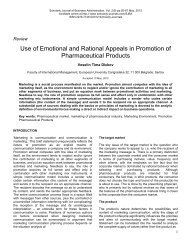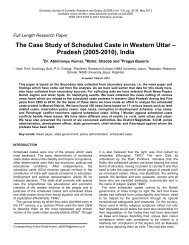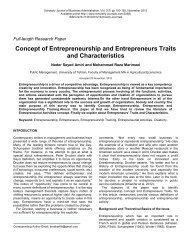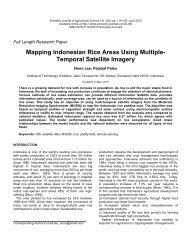Full Article - PDF - Scholarly Journals
Full Article - PDF - Scholarly Journals
Full Article - PDF - Scholarly Journals
Create successful ePaper yourself
Turn your PDF publications into a flip-book with our unique Google optimized e-Paper software.
<strong>Scholarly</strong> Journal of Medicine, Vol. 2(7) pp. 104-107 October, 2012<br />
Available online at http:// www.scholarly-journals.com/SJM<br />
ISSN 2276-7134 ©2012 <strong>Scholarly</strong>-<strong>Journals</strong><br />
<strong>Full</strong> Length Research Paper<br />
Schistosoma haematobium Infections among school<br />
children in Keffi Town, Nasarawa State, Nigeria<br />
Ishaleku D*, Yako A.B, Usman D and Azamu S.A<br />
Microbiology Unit, Department of Biological Sciences, Nasarawa State University Keffi,<br />
P. M. B. 1022 Keffi, Nasarawa State Nigeria,<br />
Accepted 19 September, 2012<br />
Using cleaned, autoclaved wide mouthed universal bottles and instructed by demonstration on how to<br />
provide urine for the study, 20mls of clean early morning mid-stream catch urine samples were<br />
collected from 200 pupils in Keffi Town. With the assistance of their Teachers, pupils’ basic<br />
epidemiological information was obtained through constructed questionnaires. The specimens were<br />
labelled, parked appropriately and taken to the laboratory for analysis. Using a reagent strip and the<br />
manufacturer’s colour chart, the amount of blood in the urine was estimated. The sedimentation method<br />
was used and the sediment transferred onto clean grease free glass slide, and examined<br />
microscopically. Of the 200 samples (98 males and 102 females), 61(30.5%) were infected with<br />
Schistosoma haematobium, in which males had a prevalence of 15.0% compared to 15.5% among<br />
females. The statistical analysis revealed that there was no significant difference (P0.05) in<br />
Schistosoma haematobium infection among the 4 schools in the study area. There was also a strong<br />
association between the prevalence of Schistosoma haematobium and haematuria among the pupils.<br />
Key words: Schistosoma haematobium, Prevalence, School children, Haematuria, Keffi Town.<br />
INTRODUCTION<br />
Urinary Schistosomiasis also called Bilharzias is a<br />
parasitic disease caused by a digenetic blood fluke of the<br />
genus Schistosoma called Schistosoma haematobium.<br />
The disease is the second most prevalent neglected<br />
tropical diseases after hookworm (Hottez and Kamath,<br />
2009) and remains an important public health problem<br />
globally especially in the Sub-Saharan African. Of the<br />
world’s 207 million estimated cases of Schistosomiasis,<br />
93% occur in the Sub-Saharan Africa (192 million) with<br />
largest number (29 million) in Nigeria followed by United<br />
Republic of Tanzania (19million) (Hottez and Kamath,<br />
2009). Although Schistosoma haematobium infection do<br />
not always result in clinical diseases and many infections<br />
are asymptomatic, S. haematobium infection is said to<br />
produce bladder wall pathology in approximately<br />
18million people in Sub-Saharan African and 10million<br />
*Corresponding Author Email; ishalekudavid@roketmail.com<br />
people suffer from hydronephrosis and renal failure (Van<br />
der Werf et al., 2003). A significant percentage of women<br />
and men with urinary Schistosomiasis acquire genital<br />
ulcers and other lesions (Kjetland et al., 2006). Poor<br />
reproductive health including sexual dysfunction and<br />
infertility [4].Genital Schistosomiasis has also been<br />
incriminated to promote horizontal transmission of<br />
HIV/AIDS in Sub-Saharan African (Kjetland et al., 2006).<br />
In addition to the organ-specific pathology for S.<br />
haematobium infections, there is also an increasing<br />
evidence for more generalized morbidity resulting from<br />
chronic inflammation of these long-standing infections<br />
(Kjetland et al 2006, King et al., 2005). The most<br />
important are anaemia of chronic inflammation and iron<br />
deficiency anaemia, growth stunting and malnutrition<br />
among children, fatigue and diminished physical fitness<br />
and impaired cognitive developments among school<br />
children (Kjetland et al 2006, King et al., 2005).<br />
There are several factors contributing to the high rate of<br />
Schistosoma haematobium infection in developing
<strong>Scholarly</strong> J. Med. 105<br />
Table 1. The prevalence of Schistosoma haematobium infection among the 4 schools in relation to sex<br />
Sex No. Sampled No. infected Percent (%)<br />
Male 98 30 15.0<br />
Female 102 31 15.5<br />
Total 200 61 30.5<br />
X 2 =386.17, P
Ishaleku et al. 106<br />
Table 2. The prevalence of S. haematobium infection among the 4 schools in relation to age<br />
Age Group No. Sampl No. infected % infection<br />
5-7 25 07 3.5<br />
8-10 65 20 10.0<br />
11-13 76 25 12.5<br />
14-16 37 09 4.5<br />
Total 200 61 30.50<br />
X2=388.3, P
<strong>Scholarly</strong> J. Med. 107<br />
for participating in this study and excellent cooperation<br />
during the study. We are also very grateful to the School<br />
Authorities and the Local Government Area Education<br />
Authority for their kind permission.<br />
REFERENCE<br />
Anosike, JC, Nwoke, BEB, Njoku, AJ (2001). The validity of haematuria<br />
in the community diagnosis of urinary schistosomiasis infections. J<br />
Helminthol. 75: 223-225.<br />
Ekpo, UF, Deile, AL, Oluwale, AS, Sam-Wobo, SO, Mafiana, CF (2010).<br />
Urinary schistosomiasis among preschool children in a rural<br />
community near Abeokuta, Nigeria. Parasites and Vectors, 3: 58.<br />
Hottez, PJ, Kamath, A (2009). Neglected tropical diseases in Sub-<br />
Saharan Africa: Review of their prevalence, distribution and disease<br />
burden. Plos Negl Trop Dis. 3(8):412.<br />
King, CH, Dangerfield-Cha, M (2008). The unacknowledged impact of<br />
chronic schistosomiasis, Chronic Illn. 4(1): 65.<br />
King, CH, Dickman, K, Tisch, DJ (2005). Reassessment of the cost of<br />
chronic helmintic infection: a meta-analysis of disability-related<br />
outcomes in endemic schistosomiasis. Lancet, 365(9470): 156.<br />
Kjetland, EF, Ndhlovu, PD, Gorno, E, Mduluza, T, Midzi, N, et al (2006).<br />
Association between genital schistosomiasis and HIV in rural<br />
Zimbabwean women. AIDS. 20: 593.<br />
Lyam, A (2006). Nasarawa State. In: Mamman, A. B; Oyebanji, J. O.<br />
and Fetters, S. W. (ed2s) Nigeria: A people united; A future assured,<br />
survey of States. Mellennium edition, Gabumo Press Nigeria, 2000;<br />
pp383-385<br />
Mafiana, CF, Ekpo, UF, Ojo, DA (2003). Urinary schistosomiasis in<br />
preschool children in settlement around Oyan Reservoir in Ogun<br />
State, Nigeria: implication for control. Trop.Med Int Health. 8(1): 78-<br />
82.<br />
Nigeria Population Commission (NPC).<br />
Swai, B, Poggensee, G, Mtweve, S, Krantz, I (2006). Female genital<br />
schistosomiasis as an evidence of a neglected cause of productive illhealth:<br />
A retrospective histopathological study from Tanzania, BMC<br />
infect. Dis. 6: 134.<br />
Uneke, C, Ugwuok-Adibuah, S, Nwakpu, K, Ngwu, B (2010). An<br />
assessment of Schistosoma haematobium infection and Urinary tract<br />
bacterial infection amongst school children in rural eastern Nigeria.<br />
The internet jou. of Laboratory medicine, 4:1<br />
Van der Werf, MJ, de Vias, SJ, Brooker, S, Looman, CW, Nagelkerke,<br />
NJ, et al (2003). Quantification of clinical morbidity associated with<br />
schistosoma infection in Sub-Saharan Africa. Acta trop. 86(2-3): 125.
















